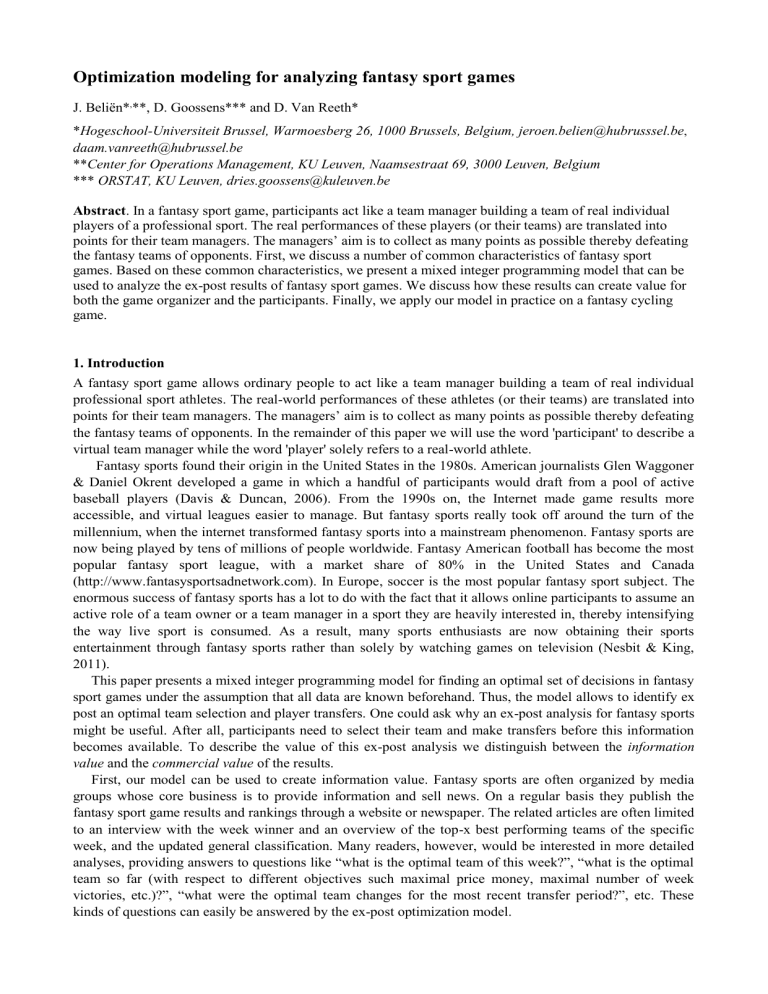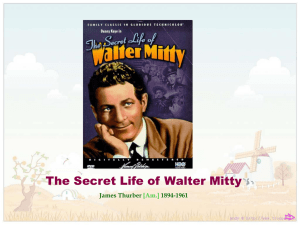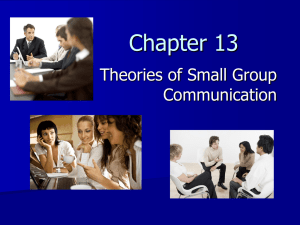We developed a general ex-post optimization model for

Optimization modeling for analyzing fantasy sport games
J. Beliën* , **, D. Goossens*** and D. Van Reeth*
* Hogeschool-Universiteit Brussel, Warmoesberg 26, 1000 Brussels, Belgium, jeroen.belien@hubrusssel.be
, daam.vanreeth@hubrussel.be
** Center for Operations Management, KU Leuven, Naamsestraat 69, 3000 Leuven, Belgium
*** ORSTAT, KU Leuven, dries.goossens@kuleuven.be
Abstract . In a fantasy sport game, participants act like a team manager building a team of real individual players of a professional sport. The real performances of these players (or their teams) are translated into points for their team managers. The managers’ aim is to collect as many points as possible thereby defeating the fantasy teams of opponents. First, we discuss a number of common characteristics of fantasy sport games. Based on these common characteristics, we present a mixed integer programming model that can be used to analyze the ex-post results of fantasy sport games. We discuss how these results can create value for both the game organizer and the participants. Finally, we apply our model in practice on a fantasy cycling game.
1. Introduction
A fantasy sport game allows ordinary people to act like a team manager building a team of real individual professional sport athletes. The real-world performances of these athletes (or their teams) are translated into points for their team managers. The managers’ aim is to collect as many points as possible thereby defeating the fantasy teams of opponents. In the remainder of this paper we will use the word 'participant' to describe a virtual team manager while the word 'player' solely refers to a real-world athlete.
Fantasy sports found their origin in the United States in the 1980s. American journalists Glen Waggoner
& Daniel Okrent developed a game in which a handful of participants would draft from a pool of active baseball players (Davis & Duncan, 2006). From the 1990s on, the Internet made game results more accessible, and virtual leagues easier to manage. But fantasy sports really took off around the turn of the millennium, when the internet transformed fantasy sports into a mainstream phenomenon. Fantasy sports are now being played by tens of millions of people worldwide. Fantasy American football has become the most popular fantasy sport league, with a market share of 80% in the United States and Canada
(http://www.fantasysportsadnetwork.com). In Europe, soccer is the most popular fantasy sport subject. The enormous success of fantasy sports has a lot to do with the fact that it allows online participants to assume an active role of a team owner or a team manager in a sport they are heavily interested in, thereby intensifying the way live sport is consumed. As a result, many sports enthusiasts are now obtaining their sports entertainment through fantasy sports rather than solely by watching games on television (Nesbit & King,
2011).
This paper presents a mixed integer programming model for finding an optimal set of decisions in fantasy sport games under the assumption that all data are known beforehand. Thus, the model allows to identify ex post an optimal team selection and player transfers. One could ask why an ex-post analysis for fantasy sports might be useful. After all, participants need to select their team and make transfers before this information becomes available. To describe the value of this ex-post analysis we distinguish between the information value and the commercial value of the results.
First, our model can be used to create information value. Fantasy sports are often organized by media groups whose core business is to provide information and sell news. On a regular basis they publish the fantasy sport game results and rankings through a website or newspaper. The related articles are often limited to an interview with the week winner and an overview of the top-x best performing teams of the specific week, and the updated general classification. Many readers, however, would be interested in more detailed analyses, providing answers to questions like “what is the optimal team of this week?”, “what is the optimal team so far (with respect to different objectives such maximal price money, maximal number of week victories, etc.)?”, “what were the optimal team changes for the most recent transfer period?”, etc. These kinds of questions can easily be answered by the ex-post optimization model.
Moreover, the model can also be used to provide individual feedback to participants (e.g., through a personal website account) that specifically concerns the participant’s team. For instance, given the participant’s starting team, which were the optimal transfers with respect to a particular game objective?
What was the highest ranking that could be achieved (at this moment)? Our model can thus be used to generate information that goes much further than only providing the participant’s current ranking. We are convinced that the availability of this detailed information can be a distinguishing factor for choosing between competing fantasy sports.
Second, the results of applying our model can also have commercial value. It is our experience that an optimal strategy largely outperforms that of the best participant. Having this in mind, the last season’s optimal team can be used for the promotion campaign of the new season highlighting the (hopefully large) difference with the score of the best participant, who after all, has won the competition. By comparing these scores, people tend to overestimate their chances of winning the game. Consequently, the game can attract more participants which increases the turnover for the organizer.
A second example of how our model can create business value is by using the results to stimulate people to join the game even after it has already been started. Indeed, most fantasy sport games allow people to submit a (new) team at any time during the game (as long as they pay the participation fee). However, these late participants have to start with a handicap as the other participants have already had opportunities to collect points. That is where our model comes into play. By highlighting the difference between the last season’s optimal score (calculated by our model) and the score of the last season’s winner, one can possibly convince doubting people of still having a fair chance of winning the general classification. This will certainly be the case if this difference is (substantially) higher than the total score of the current leader. After all, new participants also have an important advantage as they face less uncertainty concerning, for instance, the players’ expected performance. Moreover, the ex-post optimal team often looks so familiar that people get the (false) impression that this optimal team could easily be predicted beforehand or that it was, at least, not that difficult to compose a team that would have beaten the current round (e.g., race or matchday) winner. Consequently, by regularly publishing the optimal team for every round and the difference with the round winner, people will be continuously stimulated to submit a new team that aims at winning a specific round.
The remainder of this paper is organized as follows. Section 2 provides a literature review and a number of common characteristics of fantasy sports. Based on these common characteristics, Section 3 presents a mixed integer programming (MIP) model that can be used to analyze the ex-post results of fantasy sport games. We discuss how we applied our model on a real-life fantasy cycling game in Section 4. Finally,
Section 5 concludes this paper and lists directions for future research.
2. Fantasy sport games: an overview
2.1 Literature review
The growth of fantasy sports has made it an important part of the sports industry. The booming popularity also stimulated research on fantasy sports and from 2005 on literature on fantasy sports really started to grow. Two directions of research are currently dominant. The first line of research is economically oriented.
It sees fantasy sports as a new form of sport consumption and studies how this affects the behavior of sports fans. Randle & Nyland (2008), Drayer et al. (2010) and Karg & McDonald (2011) all take a rather global view and look at the impact of fantasy sport participation on the various media sources fantasy sport participants use. The specific impact of fantasy sport on television ratings is analyzed by Nesbit & King
(2010), Dwyer (2011a) and Fortunato (2011), while the live attendance impact is taken up by Nesbit & King
(2011). Most of these studies basically conclude that instead of competing with traditional ways of sport consumption, fantasy sport appears to be a complementary and value-adding activity (Dwyer, 2011a). Fan loyalty and how fantasy sports can be used in customer relationship management are studied by Dwyer
(2011b) and Smith, Synowka & Smith (2010).
A second line of research analyses sociologically oriented aspects of fantasy sport participation.
Participants in fantasy sports are predominantly young, white, male and well-educated. For instance, Davis
& Duncan (2006, p. 247) state that 97,9% of the fantasy sports enthusiasts are male, 93.7% are white, and
68.7% are college graduates or postgraduates. The Fantasy Sports Ad Network
(www.fantasysportsadnetwork.com) comes to a similar conclusion. They claim that 92% of fantasy participants are male, 91% are white and 71% have a bachelor's degree or higher. According to them, the average age of a fantasy sports participant is 36.
Some of the studies focus on the reasons why sports fans participate in fantasy sports. Often cited and validated motivational dimensions are fanship, entertainment/escape, competition and social interaction (see, for instance, Farquhar & Meeds, 2007; Dwyer & Kim, 2011; Ruihley & Hardin, 2011; Lee, Seo & Green,
2012, Billings & Ruihley, 2013). Although the conclusions on the importance of some of these dimensions might differ from one study to another, the results generally suggest a pattern of fantasy sport participation that is more purposeful and active than traditional media use (Dwyer & Kim (2011), p. 70).
Other studies analyzed gender-related aspects of fantasy sport participation. The findings of these studies are diffuse.
While Davis & Duncan (2011, p. 244) conclude that " fantasy sports reinforce hegemonic ideologies in sport spectatorship, emphasizing authority, sports knowledge, competition, male-bonding, and traditional gender role ", Ruihley & Billings (2012, p. 16) find that " fantasy sport seems to be filling a specific need for women participants. (...) Motivational research indicates that there are many reasons they are drawn to it - if only they just enjoyed it to the degree that the men do.
"
2.2 Common characteristics
To our knowledge, there are no overview studies that list fantasy sports or classify them according to a certain set of characteristics. Such a work would, in fact, be virtually impossible since the number of fantasy sports is extremely large, even if one would focus on a small country like Belgium or on one single sport.
Based on observation, we therefore looked at a number of characteristics of fantasy sports we think are fairly common in fantasy sports (see Table 1). We make a distinction between organizational characteristics and game rules characteristics. Fantasy sports can either be organized by professional organizations or by amateurs. Professional organizations are usually media related, as can be seen from the list of members of the professional Fantasy Sports Trade Organization (http://fsta.org/about/members). With the organization of fantasy sports, media managers try to build customer loyalty and an increased use of their media platform.
For instance in Belgium, the popular Belgian newspapers Het Laatste Nieuws and Het Nieuwsblad were the first to organize fantasy sports in the mid 1990s as a marketing instrument to boost sales. In the case where amateurs organize a fantasy sport, it is usually amongst friends or colleagues. In such cases, participation is often free or at a very low price to cover the costs and there is usually a restriction on the number of participants in the game, especially when such amateur organized games start to create a broader appeal.
Fantasy sports organized by media companies normally do not have a limit on the number of participants and a participation fee is often required as part of the commercial exploitation of the game.
More relevant to our analysis are the game rules characteristics. We distinguish between several elements.
First, team selection in fantasy sport can either be subject to some sort of budget constraint or can be free from such a constraint. Constraints are based on a value that is given to each player that can be selected. This value is based on past performances of the player and can either be a fictitious monetary value (e.g., based on his salary or transfer price) or a sports score (e.g., ATP points in tennis). Most games usually have a budget constraint to make it impossible to select only the best, (usually high-valued) players. The remaining budget, that is the budget not spent on players, is often used as a tiebreaker in case several participants end up with the same score.
Second, in some fantasy sports players can only be selected once. If one participant picks a given player for his fantasy team, the player becomes unavailable to the other participants. Of course, this reduces significantly the number of people that can participate in the game. Therefore, in most fantasy sports players can be selected infinitely, this means by every participant independent of the decisions of the other participants. In this way, all participants have equal chances of winning and the game organizer can allow a much larger number of participants.
Third, some fantasy sports allow participants to change their fantasy team selection at well-defined moments during the season while in other fantasy sports the team selection is fixed from the start for the whole of the season. Of course, when it is possible to transfer players during the season, the game becomes
much more strategic thus creating an even more intense need and desire to follow the sport closely, which is to the benefit of the media company that is behind the game.
Fourth, while in many fantasy sports all players of a fantasy team earn points for the participant, there are also fantasy sports in which this is not the case. For instance, some soccer fantasy sports allow participants to select a basic team of 11 players and a number of substitutes. Only in case a basic player does not play on a certain matchday, the substitute can earn points for the participant. Another possibility is that only the x players with the highest score of a fantasy team earn points for the participant on each matchday or race.
Fifth, some fantasy sports only have prizes at the end of the competition while others also have day prize winners during the competition. With regular prizes throughout the season, sport loyalty and game affiliation are further increased, again very much to the benefit of the media that are behind the game. Moreover, this offers an extra incentive for participants to enter the fantasy game even after the start of the competition.
Table 1: Characteristics of fantasy sports
Gigabike Characteristic Description
Organizational characteristics
Organizers
Participation in the game
Participation cost
Professional (usually media related) OR
Amateur (usually friends or colleagues)
Limited OR
Unlimited
A participation fee has to be paid OR
Free participation
Game rules characteristics
Budget
Player distribution
Fantasy team composition
Constrained OR
Unconstrained
Remaining budget used as a tiebreaker OR
Remaining budget irrelevant
A player can only be part of one fantasy team
OR
A player can be part of many fantasy teams
Static throughout the season OR
Dynamic with a number of transfer opportunities
Calculation of points All players of a team earn points OR
Only a subset of the players of a team earn points
Prizes Prize(s) at the end of the competition only OR
A combination of prizes at the end and daily prizes
Amateur
Limited to 500
Free participation
Constrained
Remaining budget used as a tiebreaker
A cyclist can be part of many teams
Dynamic with 5 transfer opportunities
Only the 8 best players of a team earn points
Global and daily non-monetary prizes
3. Optimization model
This section presents an MIP model for finding optimal ex-post decisions in fantasy sport games (optimal start selection as well as optimal transfers). In other words, the model allows to identify an optimal strategy if one knows beforehand how many points each player will collect in each game.
We define the following sets and indices: 𝑝, 𝑝′ ∈ 𝑃 = {1,2, … , |𝑃|} Players (athletes, riders, etc.), 𝜋 ∈ 𝛱 = {1,2, … , |𝛱|}
𝑃 𝜋
⊆ 𝑃 𝑡 ∈ 𝑇 = {1,2, … , |𝑇|}
Player types (e.g., defenders, attackers, midfielders in football; leaders, domestiques in cycling, etc.),
Set of players of type
Periods. Between each pair of periods the fantasy team can be modified, 𝜏 ∈ Θ = {1,2, … , |Θ|}
𝐺 ⊆ Θ
Games, i.e., events where players can gain points (matches, races, etc.),
Sets of games that are considered as a whole for assigning prices, e.g., matchdays, months, cycling tours, etc.,
𝐺 𝑡
⊆ Θ 𝑒 ∈ 𝐸
𝐺
= {1,2, … , |𝐸
𝐺
|}
Game sets that fall into period t ,
Winning ranks that can be obtained in game set G (e.g., first, second, third, etc.).
The model parameters (coefficients, right-hand side constants) are as follows: 𝑣 𝑝𝜏
Points obtained by player p in game τ , 𝑐 𝑝𝑡
Cost of player p in period t ,
B
𝑁 𝜋𝑡
𝐴 𝑡
𝐷 𝜏 𝑎 𝑝𝜏 𝜔 𝑒𝐺
𝐻 𝑒𝐺
𝑅 𝑒𝐺
𝑄 𝜋 𝜀
Available budget,
Number of players of type
π
that have to be selected in period
Maximal number of transfers allowed in period t , t ,
Maximal number of players that can earn points for the team in game
= 1 if player p played in game
τ
; 0 otherwise,
Value (e.g., price money) of obtaining rank
Score of the opponent that obtained rank e e in game set
for game set G
G
,
,
Remaining budget of the opponent that obtained rank e for game set G ,
Maximal number of players of player type
π
in the player pool,
Very small number.
The decision variables are as follows: 𝑥 𝑝𝑡 𝑦 𝑝𝜏 𝑟 𝑡 𝑧 𝑝𝑡 𝑠 𝑝𝑡 𝑤 𝑒𝐺 𝑞 𝑝
= 1 if player
= 1 if player
Remaining budget in period
= 1 if player
= 1 if player
= 1 if player p p p p p
is in the team in period
earns points for the team in game
is included in the player pool.
τ ; 0 otherwise,
is transferred into the team in period
is a substitute in period
= 1 if the team obtains rank e t , t t
; 0 otherwise,
; 0 otherwise,
for game set g t ; 0 otherwise,
; 0 otherwise,
τ ,
The optimization model can then be formulated as follows.
Maximize st
∑ ∑ 𝑣 𝑝𝜏 𝑦 𝑝𝜏
+ 𝜀𝑟
|𝑇| 𝑝∈𝑃 𝜏∈Θ
∑ 𝑥 𝑝𝑡 𝑝∈𝑃 𝜋
= 𝑁 𝜋𝑡
∑ 𝑐 𝑝1 𝑥 𝑝1
+ 𝑟
1 𝑝∈𝑃
= 𝐵
∑ ∑ 𝑐 𝑝𝑡
(𝑥 𝑝𝑡
− 𝑥 𝑝,𝑡−1
) = 𝑟 𝑡−1
− 𝑟 𝑡 𝑝∈𝑃 𝑧 𝑝𝑡 𝑡∈𝑇
≥ 𝑥 𝑝𝑡
− 𝑥 𝑝,𝑡−1
∀𝜋, ∀𝑡
∀𝑡 > 1
(1)
(2)
(3)
(4a)
∀𝑡 > 1
∀𝑡 > 1
(4b)
∑ 𝑧 𝑝𝑡
≤ 𝐴 𝑡 𝑝∈𝑃 𝑦 𝑝𝜏
≤ 𝑥 𝑝𝑡
∑ 𝑦 𝑝𝜏
≤ 𝐷 𝜏 𝑝∈𝑃
∑ 𝑠 𝑝𝑡
= 1 𝑝∈𝑃 𝜋 𝑠 𝑝𝑡
≤ 𝑥 𝑝𝑡 𝑦 𝑝𝜏
≤ (1 − 𝑠 𝑝𝑡
) + ∑ (1 − 𝑎 𝑝′𝜏
)𝑥 𝑝′𝑡 𝑝′∈𝑃 𝜋
\𝑝 𝑥 𝑝𝑡
∈ {0,1} 𝑦 𝑝𝑡
∈ {0,1} 𝑧 𝑝𝑡
∈ {0,1} 𝑠 𝑝𝑡
∈ {0,1} 𝑟 𝑡
≥ 0
∀𝑝, ∀𝑡, ∀𝜏 ∈ 𝑇 𝑡
∀𝜏
∀𝜋, ∀𝑡
∀𝑝, ∀𝑡
∀𝑝, ∀𝑡
∀𝑝, ∀𝑡
∀𝑡
∀𝑝, ∀𝑡
∀𝜋, ∀𝑝 ∈ 𝑃 𝜋
, ∀𝑡, ∀𝜏 ∈ 𝑇 𝑡
∀𝑝, ∀𝑡 > 1
(4c)
(5)
(6)
(7a)
(7b)
(7c)
(8)
(9)
(10)
(11)
(12)
The objective function (1) maximizes the points collected over all games. In case several solutions exist with maximal points, the solution with the highest remaining budget in the final period is selected, which explains the second term in the objective function. Constraint set (2) ensures that in each period the required number of players of each type is selected. Constraint set (3) models the budget restriction for the first period. If it concerns a static fantasy game, constraint (3) suffices.
For a dynamic fantasy game, the remaining budget of a preceding period can often be used as additional budget in the succeeding period. This is modeled by the constraint sets (4a). The cost of the new players in the team, i.e., players for which (𝑥 𝑝𝑡 out, i.e., players for which (𝑥 𝑝𝑡
− 𝑥
− 𝑥 𝑝,𝑡−1 𝑝,𝑡−1
) equals 1, must be smaller than the cost players transferred
) equals -1, plus the remaining budget of the preceding period, 𝑟 𝑡−1
.
The difference is the remaining budget 𝑟 𝑡
of period t . In this scenario, the maximal number of transfers between two periods may be limited. This is handled by the constraint sets (4b) and (4c). Constraint set (4b) ensures that the binary variable 𝑧 𝑝𝑡
is forced to 1 if a player is transferred into the team. Constraint set (4c) guarantees that the maximal number of transfers is not exceeded.
Constraint set (5) models the scenario in which not all selected players automatically earn points for the fantasy team. First, in some fantasy sports, only the points of the 𝐷 𝜏
best performing players in each game 𝜏 are counted. This is modeled by constraint set (6). Second, in order to avoid that participants lose their interest in case of inactivity (e.g., caused by injury) of a selected player, some fantasy sports require participants to select a substitute player for each player type. This substitute only earns points for the team if at least one of the other players of the substitute’s type did not come into action. For instance, in some
fantasy football games, participants select four basis midfielders and one substitute midfielder. The substitute does not earn points in a particular game unless (at least) one basis player did not play that game, even in the
(unlucky) case that the substitute scored more points than the basis player. The constraint sets (7a)-(7c) model the issue of substitute players in fantasy sports. Constraint set (7a) ensures the selection of one substitute player for each player type. Constraint set (7b) guarantees that the substitute player is one of the selected players. Constraint set (7c) ensures that the substitute player can only earn points if at least one of the basis players did not play. Finally, the constraint sets (8)-(12) define the variable domains.
Model (1)-(12) can be used to find the team that would have scored the maximal number of points for every fantasy sport game that we are aware of. Objective function (1) can be easily adapted for evaluating alternative goals. For instance, if one is interested in the team that scored the most points in particular classes of games (e.g., mountain stages in cycling), only the points scored in those games are retained in the objective function. Some fantasy game variants, however, require an alternative model. They are listed hereafter.
In a first alternative scenario for a dynamic game, the participants make a start selection of players, referred to as the player pool, out of which they select subsets of players for particular (sets of) games. This should better reflect the decisions made by a real team manager, who has to compose an extensive team at the start of the season and makes a team selection for every game. To model this scenario the constraint sets
(4a)-(4c) are replaced by the constraint sets (13)-(15). Constraint set (13) ensures that in future periods only players of the player pool can be selected, while constraint set (14) restricts the number of players of each type in the player pool. Constraint set (15) defines the domain of 𝑞 𝑝
. 𝑥 𝑝𝑡
≤ 𝑞 𝑝
∀𝑝 ∀𝑡 (13)
∀𝜋 (14)
∑ 𝑞 𝑝
≤ 𝑄 𝜋 𝑝∈𝑃 𝜋 𝑞 𝑝
∈ {0,1} ∀𝑝 (15)
Second, it often occurs that one wants to know the team that would have won the most prizes (e.g., to find the team that maximizes the price money). To this aim, the objective function is rewritten as (16) and the constraint sets (17)-(19) are added.
(16) Maximize
∑ ∑ 𝜔 𝑒𝐺 𝑤 𝑒𝐺
𝐺 𝑒∈𝐸
𝐺 st
∑ ∑ 𝑣 𝑝𝜏 𝑦 𝑝𝜏
− 𝐻 𝑒𝐺 𝑡 𝑤 𝑒𝐺 𝑡 𝑝∈𝑃 𝜏∈𝐺 𝑡
∑ 𝑤 𝑒𝐺
≤ 1 𝑒∈𝐸
𝐺 𝑤 𝑒𝐺
∈ {0,1}
+ 𝜀(𝑟 𝑡
− 𝑅 𝑒𝐺 𝑡
) ≥ 0
∀𝑡, ∀𝐺
∀𝐺
∀𝑒, ∀𝐺 𝑡
, ∀𝑒 ∈ 𝐸
𝐺 𝑡
(17)
(18)
(19)
Objective function (16) maximizes the number of weighted game set winning ranks obtained by the team.
A game set is defined as a set of games for which a prize can be won. The weight 𝜔 𝑒𝐺
is typically the prize money associated with rank e in game set G . For instance, in many fantasy games, prizes are assigned on a periodical basis. Constraint set (17) ensures that rank e is obtained for a particular game set G ( 𝑤 𝑒𝐺
= 1) only if either the team’s score is higher than the score of the opponent that obtains rank e or the team obtains a score equal to the opponent’s score, but has a larger remaining budget in the corresponding period. Finally, constraint set (18) guarantees that a team can obtain at most one winning rank for each game set. This model assumes that higher ranks entail a higher value 𝜔 𝑒𝐺
which seems to be a realistic assumption. Finally, constraint set (19) defines the domain of 𝑤 𝑒𝐺
.
As most of the fantasy sports that we are aware of, if not all, entail a simpler game concept than the rules incorporated in model (1)-(12), (13)-(15) and (16)-(19), we are confident that our model can be used for a large variety of fantasy sports. For instance, the ex-post optimization model for a static fantasy sport, in which teams are fixed during the whole length of the game, is less complicated than the model for a dynamic
fantasy sport. As a matter of fact, the static model can be seen as a special case of a dynamic model with only one period. Consequently, our model can be used for the ex-post optimization of both static and dynamic fantasy sports. A similar reasoning applies to the characteristic of multiple (daily) prizes. Fantasy sports with only one end prize can be seen as a special case of the situation with multiple prizes.
Consequently, model (16)-(19), which involves multiple winning ranks, can be used for both types of fantasy sports. The same holds for the characteristic that only a limited number of players per team yield points.
Fantasy sports in which all selected players earn points on every matchday or race can be seen as a special case in which the number of players that yield points equals the team size. Finally, also the use of the remaining budget as a tiebreaker leads to a model extension as compared to the case in which the remaining budget is neglected. The latter can be seen as a special case in which the importance (weight) of the remaining budget is set to 0 in a weighted objective function.
4. Practical application: Gigabike
Gigabike is a fantasy cycling game that is hugely popular amongst Belgian and Dutch professional road cycling fans. The Gigabike population is highly representative for the typical fantasy sports participants. In the 2013 edition of the game, according to the organizers, 96,7% of the participants are male, all are white and they have an average age of 38 years. No information on the educational level of the Gigabike participants was available though. Gigabike differs from many other fantasy sports in the organizational aspect of the game. Participation in Gigabike is free but there is a limit of about 500 participants and entry is difficult and sometimes upon invitation. A further notable difference is the fact that, apart from a challenge cup, there are no prizes nor monetary rewards to be won.
The game basically operates as follows. At the start of the road cycling season, each Gigabike participant selects a team of 30 riders from a world ranking of all professional road cyclists. In this ranking, each cyclist is assigned a so-called cycling quotient (CQ) value based on his performance during the last 12 months (see http://www.cqranking.com). This value reflects the past quality of the rider and might indicate his future performance. The total CQ value of a team must be less than a given CQ budget. At each of five fixed moments during the season, one can modify the team by substituting at most five cyclists. Hence, the season consists of six periods. However, the sum of the CQ values of the incoming riders cannot exceed the sum of the values of the outgoing riders plus the remaining CQ budget of the preceding period, if any. The winner of the game is the person whose team gains the most points over the course of the whole season. Table 1 also makes clear how the fantasy sports characteristics apply to the Gigabike game.
We illustrate our model on the Gigabike game, because Gigabike represents a typical fantasy sports game when the game rules characteristics are considered. It makes use of a constrained budget, in which the remaining budget is used as a tiebreaker, there are transfer opportunities and a single cyclist can be in many different fantasy teams. Only the eight best scoring riders of each fantasy team in every race yield points.
The game also offers a broad range of different daily prizes and overall prizes. These rules make Gigabike by far the most complex fantasy sport game that we are aware of. Moreover, the Gigabike game entails a large number of riders (>3000) to select from and a large number of events (>120 race days) in which points can be earned. Hence, from a computational point of view, Gigabike poses quite a demanding test.
We applied our model to the 2012 edition of Gigabike, for which we computed ex post an optimal starting selection and optimal transfers for each of the 5 transfer periods. Our model was solved with IBM Ilog Cplex
12.3 within a few minutes of computation time. The result learned that the Gigabike winner’s score accounted for 74% of the optimal score, leaving a substantial margin for improvement. This also allows to compare the 2012 winner with winners of previous editions. Indeed, comparing the scores in absolute terms is not very meaningful, since the total number of points that can be obtained differs from year to year, because of the races that are included (e.g. Olympics), and rider’s performances (e.g. cheap vs. expensive riders collecting the most points). Computing the optimal score, however, provides a meaningful benchmark to evaluate the participant’s performance in Gigabike over the years.
We also used our model to compute, for each of the participants, their optimal transfer decisions, given their starting selection. Computationally, this is less of a challenge, since most of the variables are fixed beforehand. Apart from the fact that many participants found the resulting information highly interesting,
and tried to induce strategic insights for the next Gigabike edition, it showed that in fact all participants focusing on the end victory could still (easily) have won the game with the right transfers. In other words, selecting a starting team turned out not to be overly important in the sense that a poor choice could ruin the rest of the participant’s Gigabike experience. A good balance between the importance of the starting team and the transfers had always been a concern for the organizers, but the results of our model now finally managed to provide well-founded support in favor of the current game rules. Comparing a participant’s score with the score that could be obtained given his or her starting team, provided a method to assess the quality of this participant’s transfers. Similarly, the quality of the starting selection could be measured. The organizers used this information to give an award to the participants with the best starting team and the best transfers. Upon request, we also computed optimal starting teams and transfers for participants with different goals than the end victory (e.g. winning as many bunch-sprint races as possible).
5. Conclusion
We developed a general ex-post optimization model for fantasy sport games, allowing to compute the best decisions if one knows beforehand how many points each player will collect in each game. We argued that this model is valuable for both organizers and participants, as it produces informational and commercial value.
Based on a survey of fantasy sport games, we listed a number of common characteristics with respect to game rules. Our model is able to deal with each one of them, and hence, is suitable for any fantasy sport game we know.
A practical application to the cycling game Gigabike shows that our model is computationally manageable. Moreover, it illustrates how organizers and participants embraced the new possibilities that this model brings. Indeed, the outcome of our model justified the game rules, provided insight in the fantasy game’s tactics, allowed for the creation of extra prizes, and increased the joy of participating in the game.
References
Billings, A.C. and Ruihley, B.J. (2013) Why we watch, why we play: the relationship between fantasy sport and fanship motivations. Mass Communication and Society 16 , 5-25.
Davis, N.W. and Duncan, M.C. (2006) Sports knowledge is power: reinforcing masculine privilege though fantasy sport league participation. Journal of Sport and Social Issues 30 , 244-264.
Drayer, J., Shapiro, S.L., Dwyer, B., Morse, A.L. and White, J. (2010) The effects of fantasy football participation on NFL consumption: a qualitative analysis. Sport Management Review 13 , 129-141.
Dwyer, B. (2011a) The impact of fantasy football involvement on intentions to watch NFL games on television. International Journal of Sport Communication 4 , 375-396.
Dwyer, B. (2011b) Divided loyalty? An analysis of fantasy football involvement and fan loyalty to individual NFL teams. Journal of Sport Management 25 , 445-457.
Dwyer, B. and Kim, Y. (2011) For love or money: developing and validating a motivational scale for football participation. Journal of Sport Management 25 , 70-83.
Farquhar, L.K. and Meeds, R. (2007) The relationship of fantasy football participation with NFL television ratings. Journal of computer-mediated communication 12 , 1208-1228.
Fortunato, J.A. (2011) The relationship of fantasy football participation with NFL television ratings. Journal of Sport Administration & Supervision 3 , 74-90.
Karg, A.J. and McDonald, H. (2011) Fantasy sport participation as a complement to traditional sport consumption. Sport Management Review 14 , 327-346.
Lee, W.Y., Kwak, D.H., Lim, C., Pedersen, P.M. and Miloch, K.S. (2011) Effects of personality and gender on fantasy sports game participation: the moderating role of perceived knowledge. Journal of Gambling
Studies 27 , 427-441.
Lee, S., Seo, W.J. & Green, B.C. (2012) Understanding why people play fantasy sport: development of the
Fantasy Sport Motivation Inventory (FanSMI). European Sport Management Quarterly , prepublished online.
Nesbit, T.M. and King, K.A. (2010) The impact of fantasy sports on TV viewership. Journal of Media
Economics 23 , 24-41.
Nesbit, T.M. and King, K.A. (2011) Major League Baseball attendance and the role of fantasy baseball.
Journal of Sports Economics 13 , 494-514.
Randle, Q. and Nyland, R. (2008) Participation in internet fantasy sports leagues and mass media use.
Journal of website promotion 3 , 143-152.
Ruihley, B.J. and Billings, A.C. (2012) Infiltrating the boys' club: motivations for women's fantasy sport participation. International Review for the Sociology of Sport ; prepublished online.
Ruihley, B.J. and Hardin, R.L. (2011) Beyond touchdowns, homeruns, and three-pointers: an examination of fantasy sport motivation. International Journal of Sport Management & Marketing 10 , 232-256.
Smith, A.A., Synowka, D.P. and Smith, A.D. (2010) Exploring fantasy sports and its fan base from a CRM perspective. International Journal of Business Innovation and Research 4 , 103-142.








